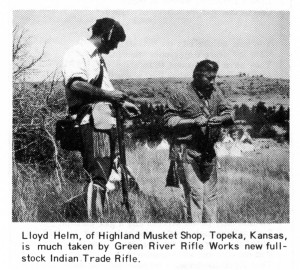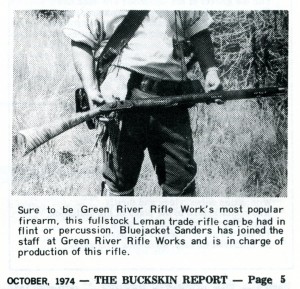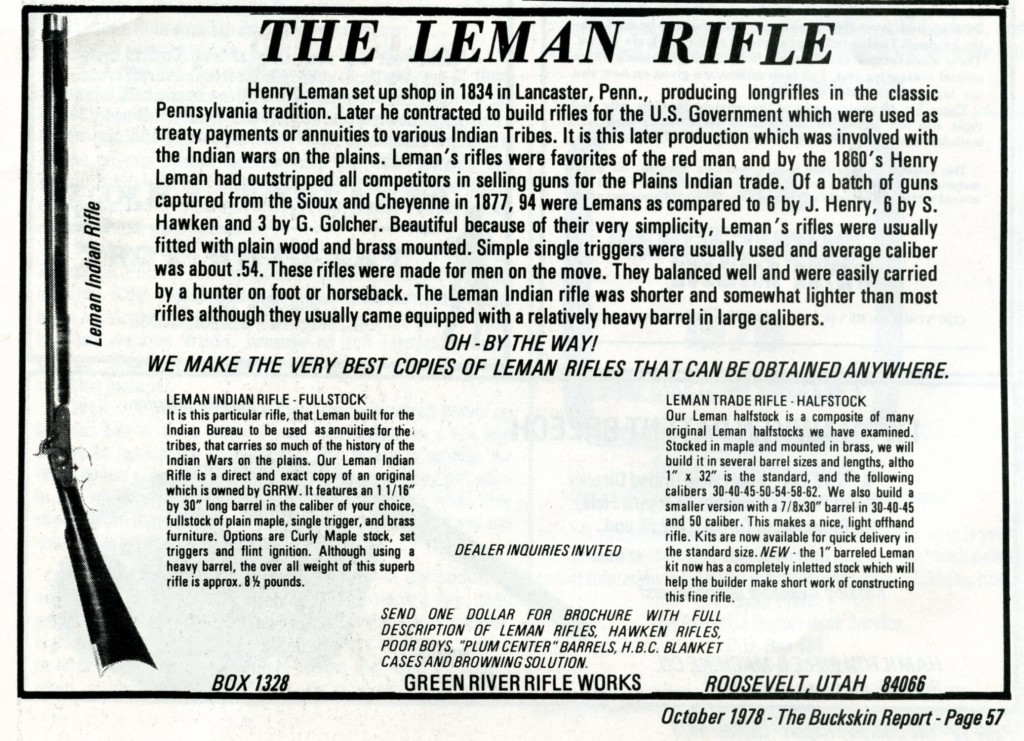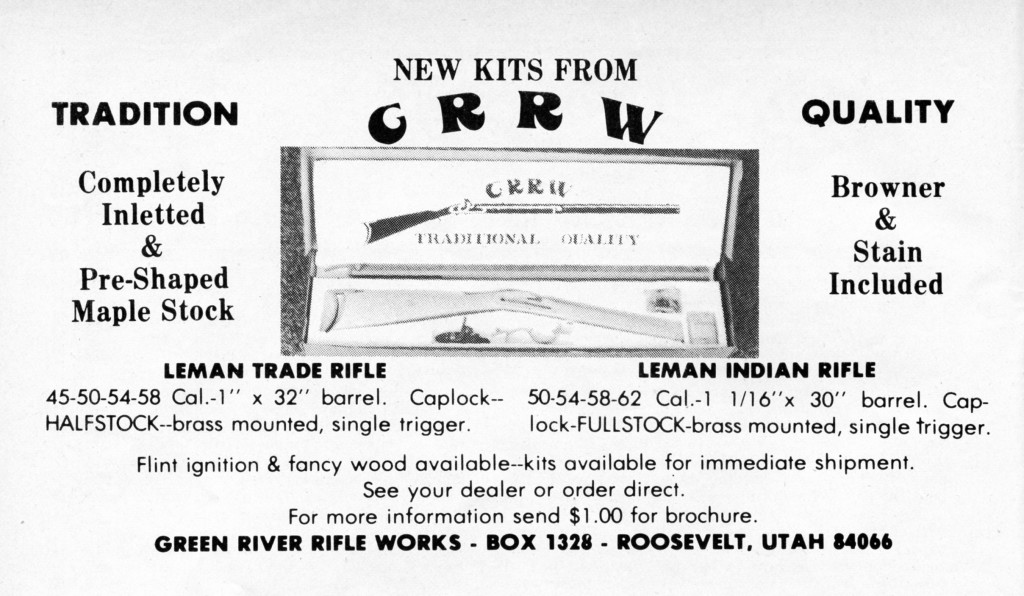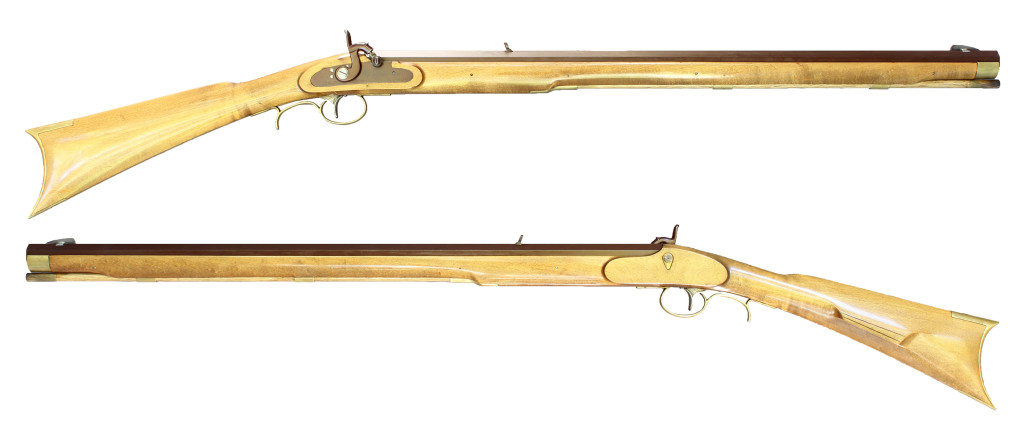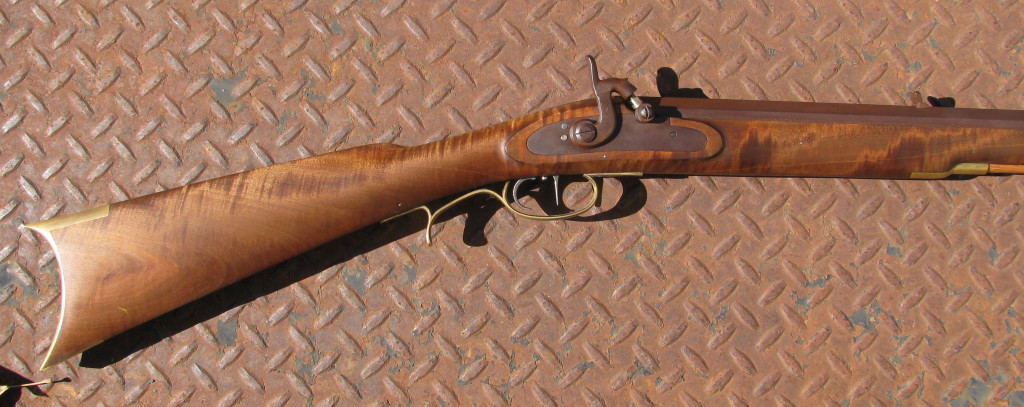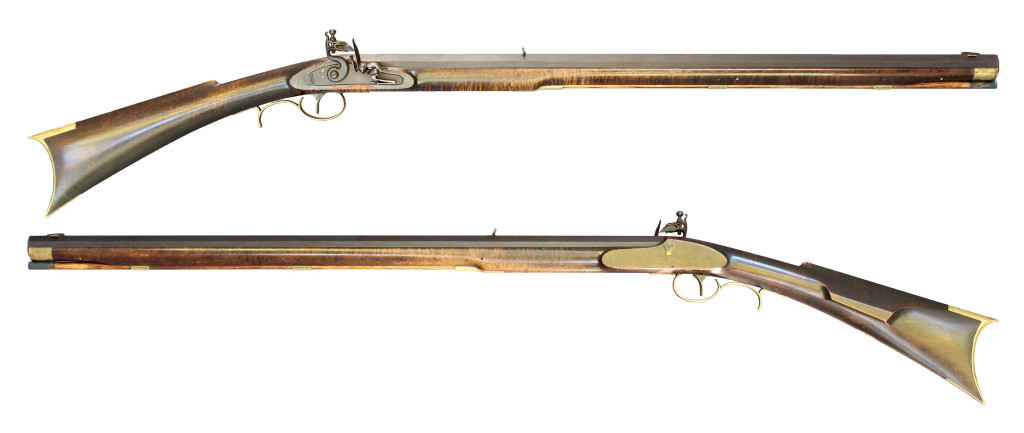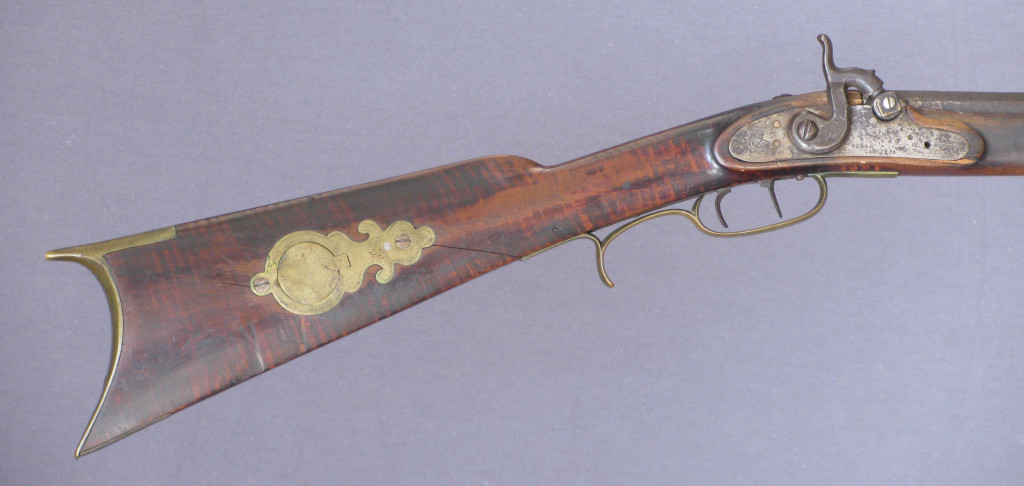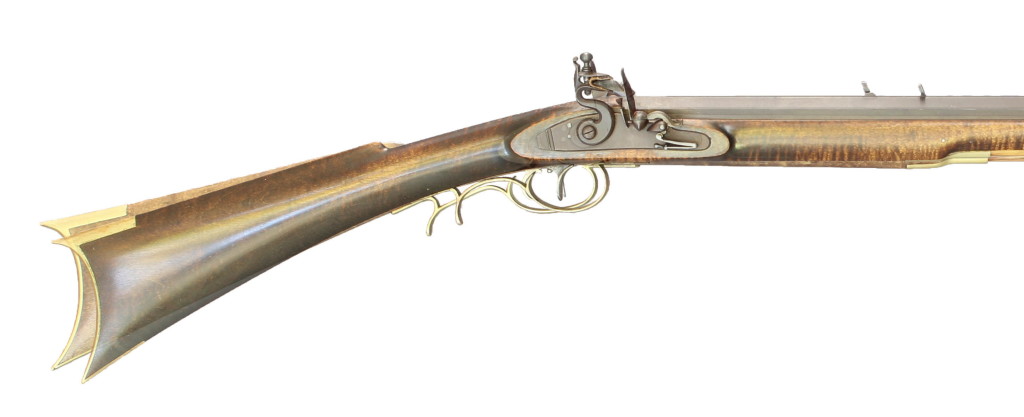“Greg Roberts, formerly of Nederland, Colorado…came to Roosevelt, bought into Green River Rifle Works and took over as General Manager…Greg was quick to introduce refinements and improvements that brought their line of firearms to a point of perfection in replica firearms…The ability to create fine muzzle loading firearms has been enhanced by the type of people Greg Roberts was able to attract to Green River Rifle Works. Phil “Bluejacket” Sanders from Illinois, Bruce White from Indiana, Carney Pace from Kansas, Ed Trump from Colorado, Vernon Simons and Russell Snaith from Virginia, Ron Paull from Florida–such men can only be described as buckskinners who are extremely proud to be making fine muzzle loading firearms that will be used by other buckskinners.”
Bluejacket Sanders joining the work force at GRRW meant that not only would this talented craftsman bring needed skills in the shop but meant that his specialized knowledge in Indian trade rifles and Northwest Guns of the fur trade era would be put to good use.
John D. Baird, November 1974 issue of The Buckskin Report, pg 10, 11
The Prototype Rifle
Not long after joining GRRW, Bluejacket set out to improve the accuracy of some of GRRW rifles. Gary “Doc” White had a couple of original Leman rifles in his personal collection, and Bluejacket used them as his inspiration. He proceeded to make models of the trigger guard and butt plate on the originals to replace the commercial guard and butt plate that GRRW had been using on their Leman Trade Rifle. The commercial guard and butt plate were a little too large and bulky to duplicate the slim lines of the original rifles.
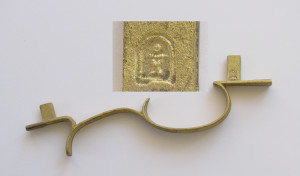
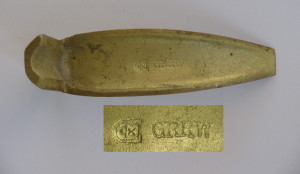
GRRW had proprietary molds made of Bluejackets models and contracted with a foundry to make castings. These castings are easily recognized because they have cast into them Bluejackets makers mark, and on the butt plate, the GRRW stamp as seen in these photos. As a side note, these castings apparently continued to be available after GRRW closed in 1980, for some other companies such as Rocky Mountain Rifle Works of Kaysville, UT and Oregon Trail Riflesmiths of Boise, ID used them on their copies of GRRW’s Leman well into the 1980’s. (Click on photos to englarge)
Bluejacket’s prototype rifle was taken to the NMLRA Buckskin Rendezvous at Buffalo, WY and the NAPR Rendezvous at Big Timber, MT in the summer of 1974. It stimulated a lot of interest in the rifle, and the factory version of the rifle went into production late that year.
The prototype or concept rifle that Bluejacket built had been sold, even though it was Doc White’s personal property, and he didn’t intend for it to be sold. The buyer was a resident of Vernal, Utah and had used the rifle extensively when he was younger, but age had forced him to it put away. An ad in the local paper by a person that was looking for a quality muzzleloader prompted the original owner to sell it. After all those years, the rifle resurfaced just down the road from where it was made.
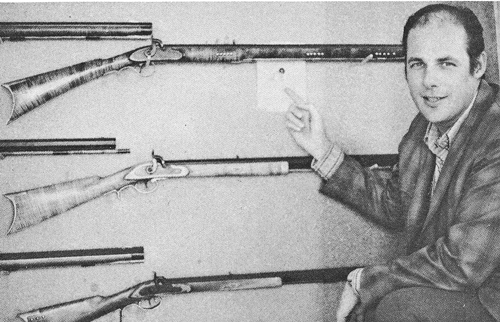
Doc White is pointing to the prototype Leman Indian Rifle that Bluejacket Sanders built in this photo from 1974 or 1975.
The standard Leman Trade Rifle is shown in the middle, and the scaled down Little Leman is near the bottom of the photograph.
The prototype rifle as it appears today is shown in the photo below.
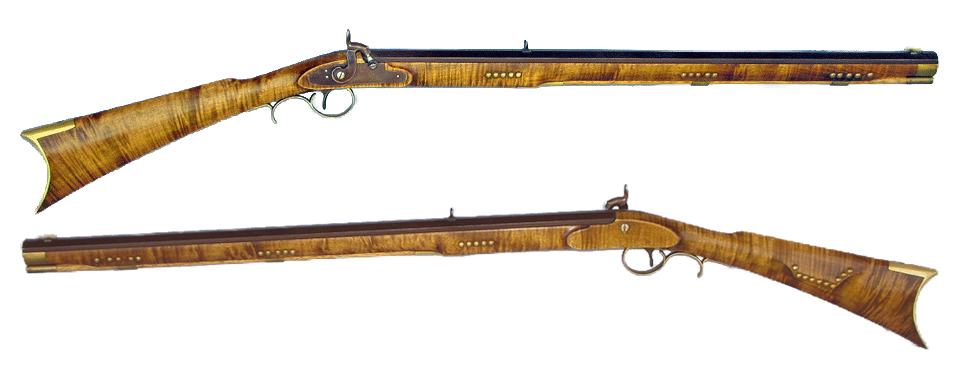
The Production and Kit Rifles
The GRRW 1974 catalog called the new rifle the “LEMAN model 1858 INDIAN RIFLE”. It included the following description:
LEMAN model 1858 INDIAN RIFLE – Leman’s later production was characterized by rifles made for the plains and mountain trade. Short, light and heavy caliber, made for use in the saddle. Fully 50% of the guns taken from the Indians in the 1870’s were of this type. They’re great for horseback hunting, or in heavy brush and timber.
Specifications – maple fullstock with GRRW barrel, one by 30 inches, mounting open rear and blade front sights and beautifully browned. Flint type britch with your choice of ignition. GRRW patent touch-hole if flint, drum and Amco nipple if percussion, single trigger, all brass fittings, including brass cap-box, supply of brass tacks for your individual decoration, calibers 45-50-54-58, pull 14 inches, weight about 8 pounds.
Finished Rifle $400.00
Semi-Finished Rifle 360.00
Basic Kits 175.00
By the time GRRW published their next catalog, sometime in 1975, the specifications for the rifle changed to a slightly larger diameter barrel and the prices went up.
LEMAN INDIAN RIFLE (model 1858) – Henry Leman built many rifles for the government which the Indian Bureau used as treaty payments or annuities to the various Indian tribes. This particular model characterized that production and remains today a rifle to “run buffler with”. The short heavy barrel [1¹/16” x 30” long] made it a favorite for use off horseback and the most frequently used calibers were 54 & 58. This rifle was commonly made with a plain maple stock which was artificially striped so we will offer it with either a plain stock or a plain stock which is artificially striped or a curly maple stock although the latter was not common. Weight about 8½ pounds.
Prices for the Finished Rifle start at $500.00
Basic Kits 200.00
Note also that the 1975 catalog no longer lists the cap-box as an option. Bob Allen has one factory Leman Trade Rifle in his collection with a cap-box. There are also some Leman Indian Rifle kit guns that have a cap-box. With the kit guns, we don’t know if the cap-box came with them or if the builder added it as an after-market item.


The 1976 GRRW catalog has pretty much the same description for the Leman Indian Rifle as the 1975 catalog, but it dropped the description and option for the artificially striped stock. Like the cap-box, I’ve not seen a GRRW rifle with artificial stripping. It’s very interesting that they even offered it for the short period they did. It seems they were way ahead of their time. Henry Leman often artificially striped his trade rifles and other builders from Lancaster and Philadelphia painted artificial stripes on their trade rifles in the first half of the 19th century, so it was a very common finish on period trade rifles. Few contemporary builders of longrifles have used that treatment on their rifles. Jack Brooks is one of them and describes how he does it on his website.
LEMAN INDIAN RIFLE – Henry Leman built many rifles for the government which the Indian Bureau used as treaty payments or annuities to the various Indian tribes. This particular model characterized that production and remains today a rifle to “run buffler with”. The short heavy barrel [1¹/16” x 30” long] made it a favorite for use off horseback and the most frequently used calibers were 54 & 58. This rifle was commonly made with a plain maple stock. But can be furnished with fancy maple at extra cost. Pull 14 inches, weight about 8½ pounds.
Two Year Delivery Schedule – Final Price for the Finished Rifle TBD When Rifle is Built
By 1976, the demand for GRRW half stock Hawken rifles and Leman Trade Rifles was so great that their 1976 catalog states, “the full stock Leman Indian Rifle and the full stock Hawken in either flint or percussion, are at present on approximately a 2 year delivery schedule.” We suspect that, as a result, few Leman Indian Rifles were built in 1975 and 1976.
We don’t see GRRW advertising the Leman Indian Rifle until the October 1978 issue of Buckskin Report and the November-December 1978 issue of Muzzleloader magazine.
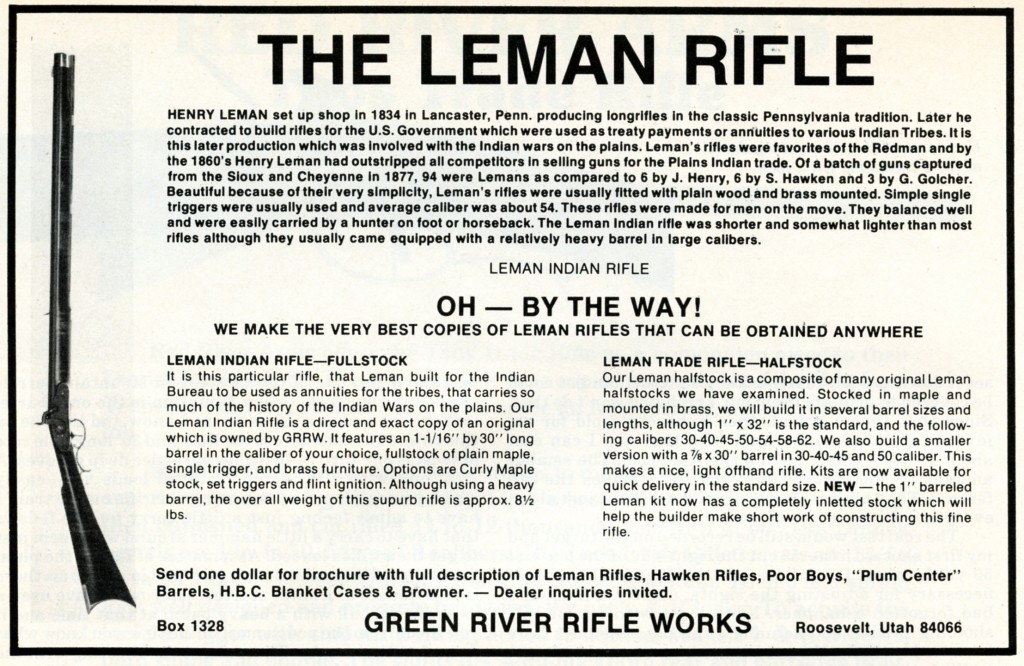
Around this time, GRRW had set up jigs and milling operations to machine inlet most of the mortices in the Leman stock. As seen in the ads above, by 1978 they were offering a completely inlet stock for the Leman Trade Rifle. This labor saving advancement in their manufacturing process was also extended to the Leman Indian Rifle. By 1979, they were advertising completely inlet half stock and full stock Leman rifles.
I ordered a Leman Indian Rifle kit from GRRW in 1979. Its stock was fully shaped and 95% inlet for all the metal parts. The note on the invoice, where it says “plain fajen”, suggests that they may have had Fajen shaping and inletting the stocks for their Leman rifles at this time.
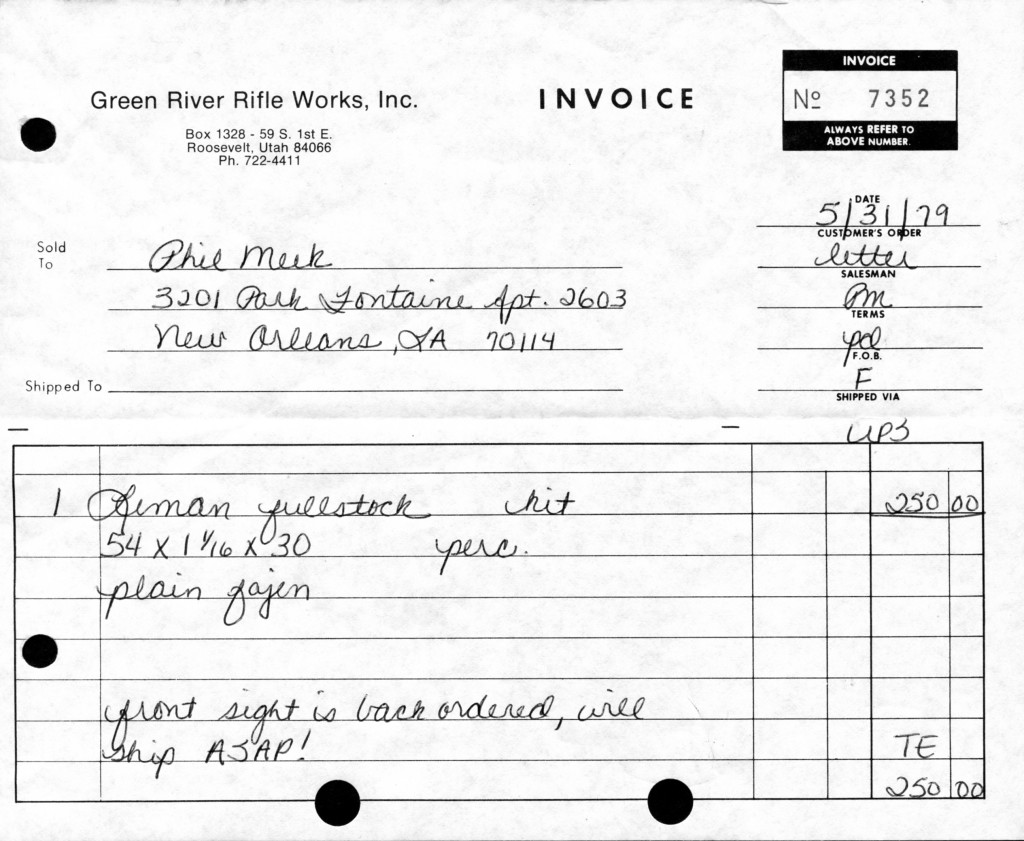
Here is a picture of the kit rifle that I assembled in 1979 on a card table in the bedroom of my small apartment in New Orleans.
The stain that was provided with the kit has faded over time. It may have been of the chromic acid variety because the stock has a very slight green tinge in certain light. A future project may be to refinish the rifle with a darker stain and reshape the lock panels to remove some more wood and slim them down around the lock plate.
The inlets in this kit were slightly undersize and only required a small amount of additional wood removal to get the metal parts to fit in the stock. The stock was also shaped close to final size, requiring a small amount of file work, then sanding and finishing. I really like the browning solution that GRRW provided with their kits. The barrel on this rifle has a very deep, rich, plum brown. The biggest challenge in assembling this kit was in drilling and tapping for the tang bolt and lock bolt.
Bluejacket based his copy of a full stock Leman rifle on an original in Doc White’s collection. The original was stolen along with several other guns in May of 1976.
We don’t have any pictures of the original Leman that was stolen, but the one below from Jim Gordon’s collection is surprisingly similar to the description except that the butt plate is brass, not iron.
The rifle below is purported to be a factory rifle, but I can’t see a serial number or makers mark in the photos I have of it. The quality of the build appears equal to factory finished rifles. The adjustable rear sight is, in all likelihood, an aftermarket change. A couple interesting features: 1) it has a single set trigger, and 2) the description given of the rifle says it has a 1” barrel. If this is correct, it could be one of the early versions described in the 1974 catalog.
The factory rifle below has a serial number in the 150’s and was built by Bill McCay. It has the standard features and dimensions except for the double set triggers. The barrel is 1¹/16” x 30” long and .50 caliber. The stock has some faint figure with a little birdseye on the lock side and some irregular curl on the offside.
This next rifle has a SN in the 190’s. It was stocked by Neill Fields. It has the standard barrel dimensions and is .54 caliber. In addition to the double set trigger upgrade, it has the extra cost fancy wood.
The last factory rifle we’ll look at is one of the highest serial numbered Leman Indian Rifles we know of, being in the upper 230’s. It was finished in August 1980, less than a month before the banks shut down GRRW, making it one of the last factory rifles finished before the company closed. It was built by Carl Walker and is a .50 caliber. The stock is a beautiful flame maple, and it has the double set triggers upgrade.
This sampling of GRRW Leman Indian Rifles is too small to draw firm conclusions from, but it is interesting to see so many with double set triggers. It also appears that for the percussion models, the Siler Mountain lock appears to be standard. It was used on all the rifles pictured above.
Turning our attention back to a kit gun to see what could be made from one in the right hands, this rifle appears to have been made in the late 1970’s. I don’t know for sure who the builder was, but his makers mark is a symbol of a turtle. The turtle is stamped on two different locations on the barrel and on the inside of the lock plate. There is also an ivory or bone inlay of a turtle on the bottom of the butt stock, midway between the trigger guard and toe plate. I call this rifle the Turtle Leman.
The rifle was not built from the standard Leman Indian Rifle kit. In the late 1970’s, GRRW was offering two types of kits for their Leman rifles. The Standard Kit had the stock completely shaped and pre-inlet. The Custom Kit offered the customer the option of changing barrel size, exact stock shape, length of pull, ignition, etc. The stock was only rough shaped with the barrel channel cut and the ramrod hole drilled.
This kit gun has a longer than standard barrel at 1¹/16” x 31” and is .62 caliber. As you can see, it also has a Ron Long flintlock. All the other furniture is typical GRRW Leman parts including the single trigger. It is obvious that this kit was not the Standard Kit with completely shaped and pre-inlet shock because the stock has more drop than the standard stock, and the bottom of the butt stock has some curve to it, reminiscent of the Lehigh Valley school. In addition, the stock is slimmer in the forearm and lock area and thicker in the wrist.
Even though this rifle deviates from the classic Leman Lancaster pattern, it is extremely well built and is a joy to handle and shoot. This would be a great rifle to “run buffler with” or even hunt bear.
Speaking of deviations from the classic Leman Lancaster pattern, as much as I like GRRW guns, I feel it only appropriate to point out a couple of criticisms of their factory Leman Indian Rifle. The most obvious is the small wrist that seems to pinch down from the back of the barrel to just in front of the comb. The second is the comb could be more pronounced and rise higher from the wrist.
H. E. Leman built all types of rifles, but his trade rifles generally followed the Lancaster pattern or school. The lines forming the top and bottom of the wrist are essentially parallel and only slightly smaller than the distance from the top and bottom of the stock at the back of the barrel as seen in the photo below. The comb is well defined and the top edge of the comb and bottom edge of the butt stock form straight lines.
Bluejacket undoubtedly made a faithful copy of the original in Doc’s collection, but the GRRW Leman Indian Rifle would look better if the distance from the top of the barrel to the bottom of the forearm had been reduced with a thinner web and less wood left below the ramrod hole. In addition, a thicker wrist would blend into the lock area better.
An interesting comparison can be made by superimposing an image of the Turtle Leman on top of an image of a factory Leman Indian Rifle. The builder of the Turtle Leman slimmed down the forearm by about 0.18”, and made the wrist of the Turtle Leman about 0.20” taller than the factory rifle. This makes for a better looking rifle.
In the scheme of things, these are pretty minor criticisms. GRRW Leman rifles were the most authentic replicas of that type available in the 1970’s. It’s a great little rifle, is easy to carry and with its short barrel, it handles very well. It’s a perfect choice for hunting in woods or brush or carrying in rough country.
The records aren’t clear on how many factory finished Leman Indian Rifles GRRW made and sold. The last one built was SN 242 on September 19, 1980. What complicates the issue is it appears the Poor Boy rifle shared the same serial number range with the Leman Indian Rifle sometime after the Poor Boy was introduced in 1977. This is somewhat confusing because I know of a Poor Boy with SN 32. If this Poor Boy was included in the Leman Indian Rifle serial numbers, then that would mean something less than 30 Leman Indian Rifles were made between 1974 and 1977. Maybe this unexpectedly low number reflects that few were ordered because of the 2-year delivery schedule advertised in the 1976 catalog. Base on the notice about the stolen guns, only 9 full stock Hawken rifles had been built by May, 1976, even though they were also introduced in 1974. Considering that fact, a correspondingly low production number for the Leman Indian Rifles prior to 1977 may be reasonable.
![]()

